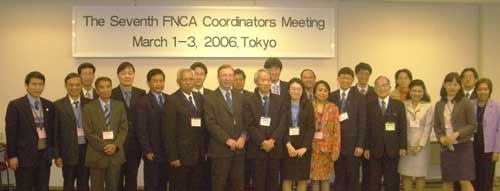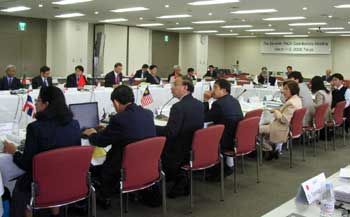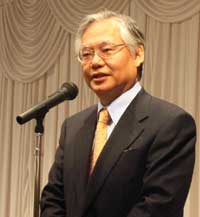| Record of the Seventh FNCA Coordinators Meeting
March 1- March 3, 2006, Tokyo, Japan
The Seventh FNCA Coordinators Meeting (CM) was held from March 1 through March 3, 2006 in Tokyo, Japan, hosted by the Atomic Energy Commission (AEC) of Japan and the Cabinet Office (CAO) of Japan.
The Meeting was attended by delegates from all FNCA countries, i.e., Australia, the People's Republic of China, Indonesia, Japan, the Republic of Korea, Malaysia, the Philippines, Thailand and Viet Nam. Dr. Abdul Aziz of Bangladesh and Dr. Nahrul Khair Alang Md. Rashid, RCA Chairman, IAEA participated in this meeting as observers.
*:FNCA coordinator
| Australia |
: |
Dr. Ronald Francis Cameron*, Executive Director, Australian Nuclear Science and Technology Organisation (ANSTO) |
| China |
: |
Mr. Zhang Jing * ,Director General, China Atomic Energy Authority (CAEA) |
| Indonesia |
: |
Dr. Soedyartomo Soentono , Chairman, National Nuclear Energy Agency (BATAN) |
| Korea |
: |
Ms. Ji-Young Park , Deputy Director, Atomic Energy Cooperation Division, Ministry of Science and Technology (MOST) |
| Malaysia |
: |
Mr. Adnan Haji. Khalid*, Deputy Director General, Malaysian Institute for Nuclear Technology Research (MINT) |
| Japan |
: |
Dr. Machi, Commissioner, Japan AEC |
| Thailand |
: |
Dr. Manoon Aramrattana*, Secretary-General, Office of Atoms for Peace (OAP) |
| The Philippines |
: |
Dr. Corazon C. Bernido, Deputy Director, Philippine Nuclear Research Institute (PNRI) |
| Viet Nam |
: |
Dr. Le Van Hong, Vice-Chairman, Vietnam Atomic Energy Commission (VAEC) |
| [Observers] |
| Bangladesh |
: |
Dr. Abdul Aziz, Member, Bioscience Division, Bangladesh Atomic Energy Commission (BAEC) |
| IAEA |
: |
Dr. Nahrul Khair Alang Md. Rashid, RCA Chairman, IAEA, Deputy Director General (Research & Technology Development), MINT |
 |
The major subjects of the Meeting were follows.
| - |
Progress, Evaluation and Planning of FNCA Projects |
| - |
ANTEP's function and the next steps including pilot program were discussed |
| - |
Report on the 6th FNCA Meeting held in Tokyo on December 1, 2005. |
| - |
Report of 2nd Panel meeting gRole of Nuclear Energy for Sustainable Development in Asiah held in January 2006 in Tokyo |
| - |
Invited speech |
1. Progress, Evaluation and Planning of FNCA Projects
8 FNCA projects implemented for the past 3-5 years were reviewed, evaluated, and the outcomes were evaluated, and recommended for future activities.
(1) Human Resources Development (HRD)
Reported on the outcome of the survey on the needs and possible training programs offered to ANTEP.
| 1) |
Delegates appreciated and supported the progress of ANTEP. |
| 2) |
The important information provided by the first survey was noted and the necessity of the second survey was recognized to provide more detailed information to allow matching of needs and possible training programs. |
| 3) |
Some countries expressed the view that the financial conditions of programs should be taken into consideration. The necessity of in-kind contribution was pointed out under the principle of partnership. Additionally, the importance of knowing the working language in the program was noted. |
| 4) |
ANTEP's function and the next steps including pilot program were discussed. |
(2) Agricultural Applications
|
1) |
Mutation Breeding (MB) |
| |
For sorghum, eleven mutant lines had been developed. The new sweet sorghum mutant variety gYuantian No.1h had been registered and produced in a large scale in China. In Indonesia, seed multiplication of drought tolerant mutant lines was conducted. Additional ion beam induced breeding materials are being studied in Indonesia, China, and Japan. For soybean, promising drought tolerant lines have been selected in Indonesia, Malaysia, the Philippines and Vietnam, and are being further evaluated for drought tolerance and yield. There was increased soybean production in Vietnam resulting from release of 10 mutants and hybrid varieties. In the sub-projects on Insect Resistance in Orchid and Disease Resistance in Banana, promising mutant lines are undergoing further evaluation. The new sub-projects to be implemented, starting in 2007, were proposed by the last workshop and the project gComposition or Quality Crop Breedingh was agreed to concentrate on rice, soybean, wheat and sorghum with all the countries participating. |
|
2) |
Biofertilizer (BF) |
| |
The project has been carried out to improve and disseminate biofertilizers by applying radiation technology in the last four years. Field demonstrations carried out in each country from 2003 to 2005 have confirmed the effectiveness of biofertilizer. Increases in the yields of different crops ranged from 2 to 122%. Economic analysis conducted by each country indicated that the application of chemical fertilizers could be reduced by 20-50% and the net income of farmers increased by as much as 58% in the case of the Philippines. Based on the proposal and evaluation of the project, the meeting agreed that the project would be extended for one more year. The work plan should include the following: (a) comparison of QA/QC of inoculant prepared by heat sterilized or radiation sterilized carriers; (b) definition of the most suitable radiation processing method for sterilization of carrier; and (c) formulation of the strategic plan for extension of biofertilizer applications including field demonstrations. |
 |
(3) Utilization of Research Reactors
|
1) |
Neutron Activation Analysis (NAA) |
| |
The activities in each participating country, with emphasis on the status of the environmental monitoring program using NAA. Delegates noted the importance of reflection of the results in the environmental policies of the participating countries through close linkage with the environmental control authorities. |
|
2) |
Research Reactors Technology (RRT) |
| |
Japan provided to member countries its neutronic calculation code SRAC, and also MVP software for accurate calculation. The countries have successfully used the code for core calculations, and gave positive feedback and results. It was noted that the project would promote the safe and stable operation, as well as advanced utilization of research reactors such as radioisotope production. There was support from the delegates for continuation and expansion of the project. |
|
3) |
Tc-99m Generator Production (TCG) |
| |
The project has established new technology to produce PZC-type Tc-99m generator. Plans for its routine production in each country, including proposals for a business plan were reported. Quality assurance for PZC material, Tc-99m and its labeled compounds for clinical use was discussed. The dissemination of PZC technology will be undertaken; the standardized manual for practical application will be finalized and published. The delegates noted that assurance of supply of Molybdenum-99 and PZC are essential for the commercial application of the technology. |
(4) Medical Care
|
1) |
Radiation Oncology (RO) |
| |
The joint clinical studies have successfully developed 3 new protocols for treatment of uterine cervical cancer whilst a new protocol for Advanced Nasopharyngeal Cancer is still under study.
The results of 5 year survival rate for two protocols for uterine cervical cancer were 53% and 66% respectively which are better than other methods used elsewhere, whilst the result of the study for another protocol (chemoradiotherapy) is not completed yet. QA/QC of radiation therapy are mandatory and the results undertaken in the seven participating countries were within the acceptable range. |
|
2) |
Cyclotron and PET in Medicine |
| |
Seven FNCA countries namely China, Indonesia, Japan, Malaysia, the Philippines, Thailand and Viet Nam have already nominated their project leaders to join the project. The first project leaders meeting (PLM) will be held in Malaysia on the 3rd quarter of 2006 to discuss the work plan for the three components of the project namely instrumentation, pharmaceuticals and diagnosis. |
|
3) |
Tc-99m Generator Production (TCG) |
| |
The project has established new technology to produce PZC-type Tc-99m generator. Plans for its routine production in each country, including proposals for a business plan were reported. Quality assurance for PZC material, Tc-99m and its labeled compounds for clinical use was discussed. The dissemination of PZC technology will be undertaken; the standardized manual for practical application will be finalized and published. The delegates noted that assurance of supply of Molybdenum-99 and PZC are essential for the commercial application of the technology. |
(5) Nuclear Safety Culture
Significant progress has been made to promote awareness and good safety culture at all levels of workers and management in the participating countries. Progress was made on the various recommendations for improvement from the self assessment and peer review conducted in Viet Nam (2002), Korea (2003) and Indonesia (2005). China may consider hosting the peer review in the near future. The project has achieved major positive outcomes in all participating countries with high ratings for achievement of out comes and scientific impact. As a result, the project will be continued for 3 more years with the planned activities to include self assessment and peer reviews, integration with other regional activities and to consider the impact of the Code of Conduct on the Safety of Research Reactors.
(6) Radioactive Waste Management
Reported on the achievements of 2005 activities including the workshop held in Japan, decommissioning/clearance task group activities in Indonesia and the Philippines and the regular publication of newsletters. The revision of the consolidated report on Radioactive Waste Management will be carried out in 2006.
(7) Industrial Application (Electron Accelerator)
It is proposed that it will be continued for three more years under the second phase (2006-2008) with the emphasis on radiation degradation of natural polymers, radiation crosslinking of natural polymers and radiation treatment of wastewater. Reported on the feasibility study on economic aspects should be carried out in the second year. It is important to make linkage with end-users in order to achieve the desired goal for industrial and commercial applications of the project. It is also expected that economic comparison studies between gamma ray facility and EB facility will also be carried out.
(8) Public Information of Nuclear Energy (PI)
Reported on the project involved two-way communications with the professional community as well as the public, development and use of effective instruments of communications such as with media, the use of a regional speakers bureau and training of nuclear communicators. All of the FNCA countries agreed that different modalities of PI should be used to reach the different target groups such as media, politicians, opinion leaders, students and teachers.
|
|
2.
Report on the Sixth FNCA Meeting |
| Dr. Sueo Machi, FNCA Coordinator of Japan gave a summary of the 6th FNCA Ministerial-level Meeting held in Tokyo on December 1, 2005. He explained the results of the round table discussions and summarized the statements of heads of delegations. |
|
|
|
Dr. Machi |
| 3. Report on gRole of Nuclear Energy for Sustainable Development in Asiah |
|
(1) |
Dr. Machi, FNCA Coordinator of Japan reported the results of the 2nd panel held on January 25-26, 2006 in Tokyo.
Some of the issues raised by delegates include: waste management and disposal, security and sustainability of energy supply including fuel supply and recycling and inclusion of nuclear power in CDM.
|
|
(2) |
The final report and recommendation for activities after 2007 will be prepared by the 3rd meeting of the panel. |
|
4. Invited Speech |
Dr. Nahrul Khair Alang Md. Rashid, RCA Chairman, IAEA made a presentation on current IAEA/RCA activities and achievements.
He stated that although RCA and FNCA have different mechanisms and approach, they have some common objectives. He suggested convergence of the two regional programs to optimize resources.
The delegates shared the view that RCA and FNCA should continue to look for opportunities to share information and resources.
|
|
|
|
Dr. Nahrul Khair Alang Md. Rashid, RCA Chairman |
|
|
Dr. Abdul Aziz, Member, Bioscience Division, Bangladesh Atomic Energy Commission (BAEC) made a presentation on gNuclear Science and Technology Programs and Activities; An Overviewh and gBiofertilizersh.
His presentation on the comprehensive nuclear program of Bangladesh covered reactor operation and maintenance, isotope production, medical services and research, health physics and radiation monitoring, non-destructive testing and the proposed nuclear power project at Rooppur.
|
|
|
|
Dr. Abdul Aziz, Member, Bioscience Division, BAEC |
|
| |
 |
Dr. Kondo, Chairman of AEC of Japan |
|
For the biofertilizer scenario in Bangladesh, he emphasized the effective application of mutation breeding of Azolla, a floating fern having N 2 -fixing Cyanobacterium.
He also mentioned about the effective cultivation of Azolla for extensive application to a number of crops including rice. He stressed radiation technology should be used to develop a new variety of Azolla which has improved insect resistance. |
|
|
